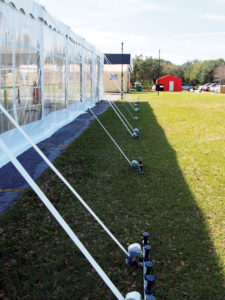
When choosing a proper anchoring method for any given site, tent renters must balance the pros and cons of staking vs. ballasting.
First, the good news: demand for event tents has significantly grown, says Steve Belliveau, sales manager, Eastern Region, for tent manufacturer Anchor Industries Inc. of Evansville, Ind. The downside? Demand has put greater pressure on tent rental companies and their installation crews with regard to properly anchoring these structures.
Determining how to safely stake or ballast a tent—and even selecting which method to use—isn’t always easy or obvious. For example, urban locations can often be extremely tight, which makes anchoring and properly tensioning the tents quite challenging, Belliveau says.
Shortened timeframes pose an additional concern, especially when it comes to staking, says Steven Eisenstein, president of Classic Tents & Events, a Norcross, Ga., tent rental company.
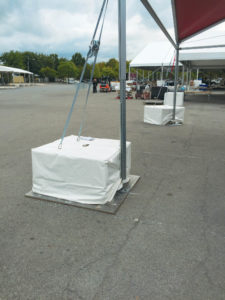
“Many times, we’re learning where the tent is landing just hours before it needs to be in the air,” says Eisenstein, explaining that this can leave the company without enough time to have underground utilities marked through the 811 “Call Before You Dig” system. In those situations, it can be safer to ballast with concrete rather than risk puncturing underground gas and water lines with stakes.
Getting clients to understand that tents actually require anchoring is sometimes an issue, says Peter McVey, owner of McVey Tent and Expo, Greenville, Wis. McVey attributes this to a misunderstanding of the word “freestanding” with regard to tents. He recalls a three-day event taking place at Green Bay’s Lambeau Field.
Because the lot had been repaved, staking wasn’t allowed.
“The client and the venue wanted us to install ‘freestanding’ frame tents with no anchoring whatsoever for the duration of the event,” McVey says. “Needless to say, we weren’t interested in doing it this way.”
McVey rejected water barrels as anchorage due to safety, cost and logistics, including the lack of a water source on-site, time to fill and place the barrels and the question of what to do with the water afterward. “Taking downs tents at night in a flooded parking lot wasn’t very appealing to us,” he says.
Instead, the company designed a ballast block that could be stacked for storage and transport. These were also designed with built-in forklift/pallet jack pockets for easy handling and placement on-site, affording a safe, economical and speedy install and takedown.
What’s underground?
A desire to avoid some of the common challenges and drawbacks of staking has sparked a trend toward more ballasting, Belliveau says.
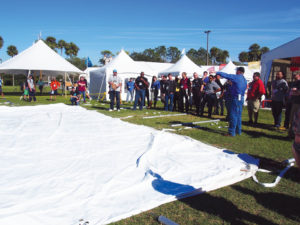
Life Safety Committee.
“Of particular concern when it comes to staking are the underground obstacles, such as water and sprinkler lines, gas, electric and the incredibly expensive, and much more prevalent today, fiber optic lines,” he says.
An aging infrastructure exacerbates staking challenges, says Donny Vasquez, vice president, marketing and special projects, for Made in the Shade Tent Rentals Inc. of West Sacramento, Calif.
“[Older] underground utilities are much weaker and prone to damage from even the slightest contact from a driven stake,” Vasquez says. “Add in that many event sites no longer have, or never had, detailed plans offering a glimpse of what is buried, and the potential for an incident increases.”
Made in the Shade employs the following process on each job before a stake ever hits the ground:
- All tent and anchoring options are discussed with the client, along with corresponding pricing.
- If staking is chosen, Made in the Shade marks out the location where the tent will be placed with white paint or chalk, or requests that the customer do this.
- An 811 ticket is initiated, to be done within 48 hours. The live ticket must be worked within 30 days.
- If questions still linger, alternative services are employed to do additional surveys.
- The client is required to have damage insurance for the property or event if staking is selected.
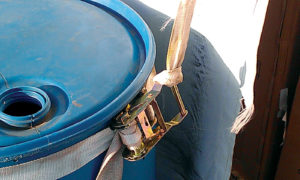
The process works the majority of the time, Vasquez says. Still, he recalls an annual home show event at a fairground where even a thorough process failed. Made in the Shade had previously used cement blocks as ballast for this event. But one year the show wanted to increase its footprint, considerably driving up the costs of transporting and installing the ballast. Because of this and other factors, the decision was made to use stakes.
“The area was marked for tent placement, the utilities marked their lines and a private company used its locating technologies and marked what they found,” Vasquez says. “The complete area was photographed using a drone. We used the high-res photos to reposition the tent placement and began work. Along one stake line of the tent, a water main was punctured, resulting in a loss of water to the complete fairground facility and a local school.”
How did this happen? It turns out the main was made of PVC (a replacement for an older line), which the locating technology couldn’t detect.
“Even though all necessary steps were taken, there’s no way of knowing exactly what’s underground,” he says. “But crew safety [is enhanced] and the liability on the rental company is greatly diminished by enacting this process.”
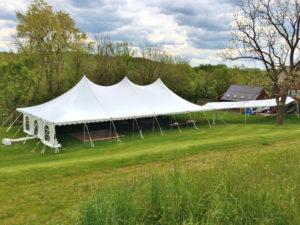
How much is enough?
There are other pitfalls associated with staking, such as having to anchor tents on loose or poorly compacted soil—a situation describing an increasing number of sites, Belliveau says.
“In these cases, larger stakes or more stakes or even different kinds of stakes and devices may have to be used,” he says.
Installing tents on blacktop or in parking lots offers additional opportunities for tent rental companies, but these surfaces can present particular challenges if staking is the chosen route, upping labor costs and requiring special equipment such as drills or mechanical stake drivers, Belliveau says. Holes will also need to be filled and repaired.
Eisenstein has dealt with some locations so difficult to drill into that staking was nearly impossible.
“Some parking lots were built over surfaces that had many layers of unknown material below,” he says. “One such location was our old baseball stadium, Turner Field. Stakes would bounce out of the spots because of the surface. We’ve also had tough challenges pulling stakes out of concrete parking lots—we’ve sometimes had to cut a stake just to get it out of the ground.”
Scott Waller, operations director for O’Neil Tents of Columbus, Ohio, says the need for ballast is always present. The key is to use it safely, properly and in sufficient amounts.
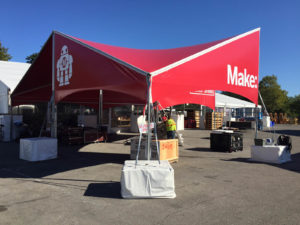
“We installed a 30-meter structure on the playing field of Ohio Stadium using ballasts,” Waller says. “These large, concrete ballasts had to be specifically engineered for this install. But with proper planning, the structure went up without a hitch.”
Waller estimates that the job required about 58 concrete ballasts, each weighing 6,000 pounds. And therein lies some of the issues associated with ballasts—storage, transporting and placement.
“Ballasting presents logistical challenges for tent rental companies,” Belliveau says. “Specialized trucks and material handling devices to move the weights around the job site and/or warehouse have to be considered before offering ballasting to the customer. You also have to consider whether these sometimes extremely large and heavy weights could damage the tent site.”
Having to haul tens of thousands of pounds of ballast around is a big endeavor even with the right tools, Eisenstein says. “The challenges we’re facing are large tractor-trailer flatbeds in small city streets and getting equipment into these spaces,” he says. “We’ve paid haulers to bring 44,000 pounds of Block and Roll® weights to our job sites.”
Vasquez cautions that some state vehicle codes, including California’s, limit how much weight can be transported in a single truckload without the use of commercial transports, which can factor into rental costs for the blocks.
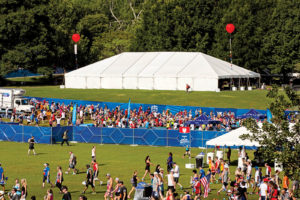
Just say no to shortcuts
One of the biggest mistakes Waller sees tent rental companies make is not putting enough weights or stakes on tents. This mistake—or deliberate shortcut—comes with potentially dire consequences.
McVey also mentions the dangers of under-ballasting, sparked in part by what he calls the “monkey see/monkey do nature of tent rental,” arguing that the industry as a whole falls short in educating companies and their installers on correct anchoring.
“There are way too many instances of five-gallon pails of concrete or even less weight being used to hold down tents,” McVey says. “One company does it and it seems to become commonplace for all companies to do it.
“I think it will eventually catch up to all companies that under-ballast or under-stake tents by way of a very high-profile accident,” he continues. “This will then create an environment for all other companies that will require more oversight, permitting and costs. It could also lead to the prohibiting of tents in certain areas.”
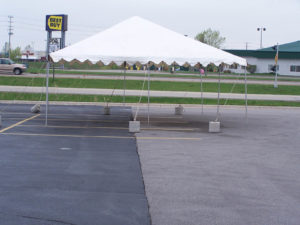
Proper tent anchorage is too important to take shortcuts and risks. Fortunately, manufacturer training and support, industry education and guidelines, and government services such as 811 exist so that a “high-profile accident” can be avoided. Safe tent installations benefit everyone—from clients and their guests, to tent crews, to the industry as a whole. And as long as the public has confidence that tent installations are safe, demand for event tents will continue to increase.
Pamela Mills-Senn is a Long Beach, Calif.-based freelance writer.
ASK FOR HELP
“One should always first seek installation instructions for their tent product from their specific tent manufacturer. They may offer training tools like videos and even offer tent schools and seminars. There’s also a lot of information available from organizations like IFAI.”
—Steve Belliveau, Anchor Industries Inc.
SAY NO
“Sometimes you just have to walk away. Unfortunately, there will always be someone willing to reduce the ballast and roll the dice, so to speak. We try to move the client to an anchoring system that is safe and also meets the requirements of the structure it will be installed on. [But] this does require a dialogue with the client, building owner and sometimes inspection officials.”
—Peter McVey, McVey Tent and Expo
SLOW DOWN
“Too often installers get into a rush, and that’s when accidents happen. Experienced installers should be well informed about the codes and standards pertaining to tent structures, wherever they may be installing. A good working relationship with an experienced structural engineer can’t hurt either.”
—Scott Waller, O’Neil Tents
Members of the Tent Rental Division (TRD) of IFAI have free access to the following:
- TRD Ballasting Tool. This online tool calculates the required amount of ballast, using a complex set of formulas that emerged from the division’s engineering study completed with Clemson University.
- IFAI Procedural Handbook for the Safe Installation and Maintenance of Tents and Fabric Structures. The latest edition of this handbook includes major revisions reflecting recent industry trends.
- IFAI Staking Study and pocket guide. This study and guide offer simplified testing techniques to determine the holding power of a stake.
To learn about these and many more benefits, go to www.ifai.com/membership.
 TEXTILES.ORG
TEXTILES.ORG



Nice article, it gives good examples